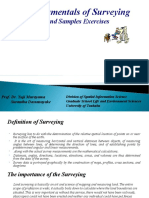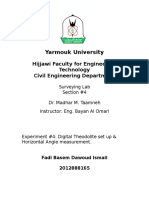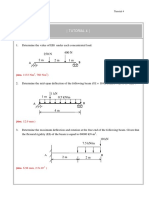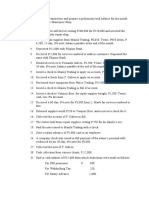Theodolite
Theodolite
Uploaded by
suwashCopyright:
Available Formats
Theodolite
Theodolite
Uploaded by
suwashOriginal Description:
Copyright
Available Formats
Share this document
Did you find this document useful?
Is this content inappropriate?
Copyright:
Available Formats
Theodolite
Theodolite
Uploaded by
suwashCopyright:
Available Formats
The Theodolite
THE THEODOLITE
A theodolite is the most precise instrument used for measuring horizontal and vertical angles accurately. It is an extremely useful instrument for exact survey works in most of the engineering projects. It consists of telescope by means of which distant objects can be sighted. It can also be used for a number of surveying operations, such as measurement of horizontal distance, determine difference in elevation, extending a straight line, layout of buildings, setting a straight line, layout of buildings, setting out curves, establishing grades, and setting out engineering works. Depending upon the accuracy and precision, many types of theodolites are available. However theodolites are primarily classified as: a) Transit Theodolite b) Non-Transit Theodolite a) Transit Theodolite: Almost all Theodolite in use now are transit. The theodolites whose telescope can be rotated in a vertical plane about its transverse horizontal axis(trunnion axis) is known as transit theodolite. Rotating telescope in a vertical plane through a complete revolution i.e. 180o is known as transiting. b) Non-transit Theodolite: The theodolite whose telescope cannot be rotated completely in a vertical plane about its transverse horizontal axis is known as non-transit theodolite. Non transit theodolites have now become obsolete. Theodolites are also classified according to reading system, as following: a) Vernier Theodolite: Vernier Theodolites are simple and comparatively cheap, and are quite commonly used. A vernier is an auxiliary scale that slides along the main scale, and is used to read the main scale more closely than its smallest division. b) Micrometer Theodolite: Micrometer Theodolite is a series of prism and with microscope, which magnifies the graduations of the circle. With the aid of magnification, readings can be observed precisely.
Principles of Theodolite construction
There are three main sections of a Theodolite: 1. Levelling head assembly: The leveling head consists of two parallel triangular plates known as tribrach plates. The upper tribrach has three arms carrying a leveling screw and a circular bubble. In the modern instruments, the shifting centre or movable head is provided to centre the instrument quickly and accurately. A leveling head has three distinct functions: To support the main part of the instrument. To attach the Theodolite to the tripod. To provide a means for leveling the Theodolite. Prepared By: Mr. Suwash Chandra Acharya, Sagarmatha Engineering College, Sanepa, Lalitpur Page 1
The Theodolite 2. Horizontal circle assembly: It onsists of the lower plate and upper plate. The lower plate carries the main scale and the upper plate carries verniers. Each plate carries a clamp screw and a corresponding slow motion or tangent screw. 3. Alidade assembly: It is the topmost assembly which includes a telescope supported by two standards of the shape of letter A forming an U-frame (which rest on the horizontal circle upper plate), and the vertical circle. An altitude bubble is attached to the standards. The basic features of a typical theodolite are, with reference to given figure, as follows: 1) The trivet stage forming the base of the instrument connects it to the tripod head. 2) The tribrach supports the rest of the instrument and with reference to the plate bubble can be levelled using the foot screws which act against the fixed trivet stage. 3) The lower plate carries the horizontal circle which is made of glass, with graduations from 0 to 360 photographically etched around the perimeter. 4) The upper plate carries the horizontal circle index and fits concentrically with the lower plate. 5) The plate bubble is attached to the upper plate and when adjusted, using the foot screws, makes the instrument axis vertical. Some modern digital or electronic theodolites have replaced the spirit bubble with an electronic bubble. 6) The upper plate also carries the standards which support the telescope by means of its transit axis. The standards are tall enough to allow the telescope to be fully rotated about its transit axis. 7) The vertical circle, similar in construction to the horizontal circle, is fixed to the telescope axis and rotates with the telescope. 8) The vertical circle index, against which the vertical angles are measured, is set normal to gravity by means of (a) an altitude bubble attached to it, or (b) an automatic compensator. The latter method is now universally employed in modern theodolites. 9) The lower plate clamp enables the horizontal circle to be clamped into a fixed position. 10) The lower plate slow motion screw permits slow movement of the theodolite around its vertical axis, when the lower plate clamp is clamped. 11) Similarly, the upper plate clamp and slow motion screw have the same effect on the horizontal circle index. 12) The telescope clamp and slow motion screw fix and allow fine movement of the telescope in the vertical plane. 13) The optical plummet, built into either the base of the instrument or the tribrach, enables the instrument to be centered precisely over the survey point. The line of sight through the plummet is coincidental with the vertical axis of the instrument.
Prepared By: Mr. Suwash Chandra Acharya, Sagarmatha Engineering College, Sanepa, Lalitpur
Page 2
The Theodolite
Fig. A typical theodolite
Fig. Simplified theodolite
Reading system of micrometer theodolite
The optical micrometer system generally uses a microscope, combined with an optical micrometer using exactly the same principle as the parallel plate micrometer on a precise level. Figure below illustrates the principle involved. If the observers line of sight passes at 90 through the parallel plate glass, the circle reading would be 2320+S, with the value of S unknown. The parallel plate is rotated using the optical micrometer screw until the line of sight is at an exact reading of 2320 on the circle. This is as a result of the line of sight being refracted towards the normal and emerging on a parallel path. The distance S through which the observers line of sight was displaced is recorded on the micrometer scale as 1140. The shift of the image is proportional to the angle of tilt of the parallel plate and is read on the micrometer scale. Before the scale can be read, the micrometer must be set to give an exact reading (23 20), as shown on Figure, and the micrometer scale reading (1140) added on. Thus the total reading is 233140.
Prepared By: Mr. Suwash Chandra Acharya, Sagarmatha Engineering College, Sanepa, Lalitpur
Page 3
The Theodolite
Fig. Micrometer
Fig. Theodolite reading system
Temporary Adjustments
The adjustment, which is required to be made at each setting of the instrument before taking observation, is known as temporary adjustment. The temporary adjustment of a theodolite is: i. ii. iii. Setting up Levelling up Elimination of parallax.
i.
ii.
Setting up: It includes the centering of the theodolite over the station and its approximate leveling by tripod legs. Centering. This involves setting of the theodolite exactly over the station mark. It is done by using plumb bob or by optical plummet. Approximate leveling with the help of tripod legs. This implies leveling the instrument with the legs of the tripod, i.e. by bringing the small circular bubble on the tribrach in the centre. To achieve this, two of tripod legs are set firmly into the ground and the third leg is moved radially to bring plumb bob exactly over the station mark and then the third leg is also pushed into the ground. Levelling up: The operation of making the vertical axis of a theodolite truly vertical is known as leveling of a theodolite. After having accurate centering and approximate leveling, accurate leveling is done with the help of leveling screw or foot screw with reference to plate levels. Following steps are involved in leveling with a three foot screws:
Prepared By: Mr. Suwash Chandra Acharya, Sagarmatha Engineering College, Sanepa, Lalitpur
Page 4
The Theodolite All the three foot screws should be preferably in the centre of their run before starting the leveling operation. Turn the horizontal plate until the longitudinal axis of the plate level is approximately parallel to a line joining any two leveling screws. Bring the bubble to the centre of its run by turning both foot screws simultaneously in opposite direction either inwards or outwards. The movement of left thumb indicates the direction of movement of the bubble Turn the theodolite through 90 so that it is at right angle to the original position. Bring the bubble to the centre by turning the third foot screw. Repeat the process till the bubble remains central in all the positions of the instrument. Elimination of parallax: An apparent change in the position of the object caused by the change in position of observers eye is known as parallax. It is the condition rising when the image formed by the objective is not in the plane of the cross hairs. Parallax can be removed in two steps a. Focussing the eyepiece: To focus the eye piece for clear and distinct vision of cross hairs, point the telescope towards sky or hold a sheet of white paper in front of telescope and move the eyepiece in or out till the cross hairs are seen sharp and distinct. b. Focussing the objective: After focusing the eyepiece, the telescope is directed towards the object to be sighted and the focusing screw is turned till the image appears clear and sharp.
iii.
Fundamental Lines of Theodolite and their relationship
The fundamental lines of theodolite are as follows: a. b. c. d. e. Vertical axis Line of collimation Horizontal axis or Trunnion axis The axis of plate level The bubble line of altitude
The relationships between fundamental axes are: a. b. c. d. The axis of plate levels must be perpendicular to the vertical axis. The line of collimation should be perpendicular to the horizontal axis. The horizontal axis must be perpendicular to the vertical axis. The vertical axis, line of collimation, and the horizontal axis meet at a point called instrument centre. e. The graduation on vertical circle must be concentric with horizontal axis. f. The graduation on horizontal circle must be concentric with vertical axis.
Prepared By: Mr. Suwash Chandra Acharya, Sagarmatha Engineering College, Sanepa, Lalitpur
Page 5
The Theodolite
Fig. Showing relationship between fundamental axis
Measurement of angles
Already performed in the field, so, you can study yourself.
Sources of errors in theodolite surveying
The source of errors in theodolite surveying may be broadly classified into three categories: I. II. III. Instrumental errors Personal errors Natural errors
I.
Instrumental errors
Theodolites are very delicate and sophisticated surveying instrument. In spite of the best efforts during manufacturing, residual errors of adjustment as well as non-adjustable errors may occur due to imperfect adjustment of the Theodolite. To safeguard from the instrumental error, it is advisable to measure face left and face right reading, and to read the opposite verniers at each observation. Different types of instrumental errors are listed below:
i.
Error due to imperfect adjustment of plate levels:
Prepared By: Mr. Suwash Chandra Acharya, Sagarmatha Engineering College, Sanepa, Lalitpur
Page 6
The Theodolite If the plate bubbles are not adjusted properly, the vertical axis of the instrument does not remain vertical even if plate bubbles remain at the centre of its run. Due to non-verticality of vertical axis, the horizontal plate gets inclined and the measurement of both the vertical and horizontal angles will be incorrect. The error can be eliminated by careful levelling with respect to the altitude bubble if it is in adjustment. ii. Error due to line of collimation not being perpendicular to the trunnion axis: If the line of collimation is not truly perpendicular to the trunnion axis, the measurement of horizontal angle between two points which are at considerable difference in elevation will be incorrect. The error can be eliminated by taking both face observations. iii. Error due to horizontal axis not being perpendicular to the vertical axis: If the horizontal axis is not perpendicular to the vertical axis, the line of sight will move in an inclined plane when the telescope is raised or lowered. Thus the measured horizontal and vertical angles will be incorrect. The error can be eliminated by taking both face readings. iv. Error due to non-parallelism of the axis of the telescope level and line of collimation: If the line of sight is not parallel to the axis of telescope level, the measured vertical angle will be incorrect since the zero line of the vertical verniers will not be a true line of reference. It will also be a source of error when the Theodolite is used as a level. The error can be eliminated by taking both face observation. v. Error due to imperfect adjustment of the vertical circle verniers: If the vertical circle vernier do not read zero when the line of sight is horizontal, the measured vertical angles will be incorrect. The error can be eliminated by taking mean of the vertical angle on both faces or by applying index correction. vi. Error due to eccentricity of inner and outer axes: If the centre of the graduated horizontal circle does not coincide with the centre of the vernier plate, the angle recorded by either vernier will be incorrect. The true angle is obtained by taking the mean of the tow vernier readings. vii. Error due to imperfect graduations: This error arises when the graduations on the scales are not exactly equidistant. Measuring the angle several times and taking the mean of them may eliminate the error due to defective graduations. viii. Error due to eccentricity of verniers: If the line joining the zeros of the horizontal plate vernier does not pass though the centre of the vernier plate, an error in the measured horizontal angle is introduced. The eccentricity of the vernier may be easily ascertained by reading both verniers on different parts of the graduated circle. Thus, the difference between the two vernier readings will not be 180. The error can be eliminated by reading both the verniers and taking the mean of the two. II. Personal errors:
Prepared By: Mr. Suwash Chandra Acharya, Sagarmatha Engineering College, Sanepa, Lalitpur
Page 7
The Theodolite Personal errors are classified into two categories: i. ii. i. Errors of manipulation Errors of sighting and reading Errors of manipulation:
a. Inaccurate centering: If the centre of the instrument is not exactly over the station, all the observed angles will be affected. The magnitude of error depends upon the distance between the Theodolite centre and ground station mark, the direction and the distance of the station sighted. Error due to defective centering varies inversely as the length of the sight. Therefore, error will be serious when the sights are short. The error of one centimetre centering in a length of 34.4 m introduces an error of one minute arc in the measured angle. It may be noted that the error due to inaccurate centering cannot be eliminated unless accurate centering is done. b. Inaccurate levelling: Inaccurate levelling introduces a serious error in the horizontal angles, when the stations sighted are at considerable difference in elevation. The error is small when the sighted stations are nearly at the same level. This error cannot be eliminated, but can be minimized by levelling the instrument carefully using the altitude bubble. c. Improper use of tangent screw: This is a common mistake on the part of the beginner. The error is introduced by using the upper tangent screw while taking the back sights or by using the lower tangent screw while taking a foresight. If the upper tangent screw is turned in taking a back sight, the mistake can be detected by checking the vernier reading before taking a foresight. But if the lower tangent screw turned in taking a foresight, the mistake cannot be detected. The observer should bear in mind that upper tangent screw changes the readings whereas the lower tangent screw swings the Theodolite without changing the reading. Therefore always remember to use the lower tangent screw for a back sight and the upper tangent screw for a foresight. d. Slip: The error due to slip may occur if the lower clamp is not properly tightened, or the shifting head is loose, or the instrument is not firmly tightened on the tripod head. As a result of slip, the orientation of the instrument is disturbed and the observations made are incorrect. ii. Errors of sighting and reading:
a. Inaccurate bisection of signals: The observed angles will be incorrect when it is not possible to bisect the signal in the centre of the ground station mark owing to an intervening bush, high ground, low compound wall, etc. In such case, care should be taken to intersect the lowest point of a ranging rod placed at the ground station mark.
Prepared By: Mr. Suwash Chandra Acharya, Sagarmatha Engineering College, Sanepa, Lalitpur
Page 8
The Theodolite Inaccurate bisection of the signal introduces an error whose magnitude varies inversely with the distance of the sight. This error is similar to that of error due to inaccurate centering. b. Non-verticality of ranging rod: This is a common source of error when the upper part of a ranging rod has to be sighted owing to the intervening obstacles. The error is inversely proportion to the length of sight. To minimize this error, the rod should be held exactly vertical and the lowest visible point should be bisected. c. Parallax: Due to parallax, accurate bisection is not possible. This error can be eliminated by focusing the eyepiece and the objective. d. Other errors: Mistake in setting the verniers, mistake in taking the reading, and mistake in booking the readings. These errors can be avoided by precautions. III. Natural errors: a. Strong wind producing vibration to the instrument. b. High temperature producing unequal atmospheric refraction. c. Unequal settlement of tripod.
Accurate work cannot be done in a high wind or on a hot sunny day. Precise work is usually done in the most favourable atmospheric conditions. In work of ordinary precision, the natural errors are negligible.
References 1. 2. 3. 4. 5. Bannister A., Raymond S., and Baker R.(1998), Surveying, 7th edition, Pearson Duggal S.K.(2009), Surveying, 3rd edition, Tata McGraw Hill , New Delhi Schofield S. and Breach M.(2007), Engineering Surveying, 6th edition, Elsevier Ltd, Oxford UK Ghilani C.D. and Wolf P.R.(2012), Elementary Surveying, 13th edition, Pearson Basak N.N.(2003), Surveying and Levelling, Tata McGraw Hill, New Delhi
Prepared By: Mr. Suwash Chandra Acharya, Sagarmatha Engineering College, Sanepa, Lalitpur
Page 9
You might also like
- Cec 209 - Civil Engineering Drawing I: Unesco-Nigeria Technical and Vocational EduDocument90 pagesCec 209 - Civil Engineering Drawing I: Unesco-Nigeria Technical and Vocational Edubashlat00No ratings yet
- Mini-Case 3: Crosswell International and BrazilDocument4 pagesMini-Case 3: Crosswell International and BrazilAbdullah IsseNo ratings yet
- Affidavit of Facts/Fraud.... MSTADocument3 pagesAffidavit of Facts/Fraud.... MSTAImhotep 8100% (2)
- Material LaboratoryDocument14 pagesMaterial LaboratoryAnonymous tLXKwTNo ratings yet
- Macaulay's Method 0910Document100 pagesMacaulay's Method 0910aflinton100% (1)
- Medine PresentationDocument35 pagesMedine PresentationKyōjux RinkānNo ratings yet
- Mohrs CircleDocument1 pageMohrs CirclesuwashNo ratings yet
- Unit 3Document40 pagesUnit 3Rajiv Kumar100% (1)
- Surveying - II PracticeI Lab Manual-NEWDocument43 pagesSurveying - II PracticeI Lab Manual-NEWPathipati Narasimharao100% (1)
- Linear Survey ReportDocument4 pagesLinear Survey ReportMbabazi IvanNo ratings yet
- 2 Peg Test ReportDocument4 pages2 Peg Test ReportIzzul ZikriNo ratings yet
- My Industrial TrainingDocument8 pagesMy Industrial TrainingOlawumi Timothy Oluwatosin100% (2)
- Experiment 1 EMDocument5 pagesExperiment 1 EMMuhammad Ishfaq0% (1)
- Leveling Final Report 151129114128 Lva1 App6891Document19 pagesLeveling Final Report 151129114128 Lva1 App6891Geoffrey NyamagodoNo ratings yet
- A Field Report On Compass SurveyingDocument13 pagesA Field Report On Compass SurveyingVin DieselNo ratings yet
- Equal Payment SeriesDocument5 pagesEqual Payment SeriesMaya OlleikNo ratings yet
- Cost Planning, Cost Control and Cost AnalysisDocument9 pagesCost Planning, Cost Control and Cost AnalysisNazatul NadiaNo ratings yet
- ArcSwat - WATERSHED TUTORIALDocument34 pagesArcSwat - WATERSHED TUTORIALBernard KitosiNo ratings yet
- Meas Lecture Note 1 Principle of Measurement Note 1Document19 pagesMeas Lecture Note 1 Principle of Measurement Note 1LokuliyanaNNo ratings yet
- Beam DeflectionDocument14 pagesBeam DeflectionPrudvi Krishna MaladiNo ratings yet
- Middle Third Rule For Rectangular Section - Engineering ApplicationsDocument4 pagesMiddle Third Rule For Rectangular Section - Engineering ApplicationsShivamKumarNo ratings yet
- Value Management in Analyzing Project Brief: January 2007Document13 pagesValue Management in Analyzing Project Brief: January 2007nazmiNo ratings yet
- FM Lab ManualDocument76 pagesFM Lab ManualsidharthNo ratings yet
- Sri Lanka Institute of Information Technology Faculty of Engineering Department of Civil EngineeringDocument21 pagesSri Lanka Institute of Information Technology Faculty of Engineering Department of Civil EngineeringmalithNo ratings yet
- Traverse Surveying - FullDocument15 pagesTraverse Surveying - Fullmohammad rihelNo ratings yet
- Total Station: Lecturers: Berchuk V.Y. Gutareva N.YDocument15 pagesTotal Station: Lecturers: Berchuk V.Y. Gutareva N.YvilmoskaNo ratings yet
- 1.0 Job/Experiment No.: Me594/05 2.0 NAME OF EXPERIMENT: Angle Measurement Using Sine Bar & SlipDocument6 pages1.0 Job/Experiment No.: Me594/05 2.0 NAME OF EXPERIMENT: Angle Measurement Using Sine Bar & SlipHimanshu Vasistha0% (1)
- Eac 2240 - Surveying 1 Contouring Notes L6Document11 pagesEac 2240 - Surveying 1 Contouring Notes L6KIBET ISAAC MASHAK ED102/G/10069/20No ratings yet
- Fundermental Surveying - Theory and Practice PDFDocument28 pagesFundermental Surveying - Theory and Practice PDFSupriya Roy100% (1)
- Surveying One NotesDocument28 pagesSurveying One NotesHype gada 254No ratings yet
- CSTLSV5001 Lsvsa501Document46 pagesCSTLSV5001 Lsvsa501JEAN DE DIEU MUVARANo ratings yet
- g20 Setting OutDocument8 pagesg20 Setting OutMohd AmranNo ratings yet
- Site Survey PresentationDocument24 pagesSite Survey PresentationAmir HafizuddinNo ratings yet
- Structure Lab-Three Hinge ArcDocument13 pagesStructure Lab-Three Hinge ArcFendi Roon100% (1)
- Hydraulics Engineering Lec #1:: Specific Energy and Critical DepthDocument20 pagesHydraulics Engineering Lec #1:: Specific Energy and Critical Deptharfa wainceNo ratings yet
- 22Document11 pages22Farah AymanNo ratings yet
- 962 PDFDocument36 pages962 PDFdipNo ratings yet
- Basic Surveying PDFDocument66 pagesBasic Surveying PDFSulchan Purnama SaputraNo ratings yet
- Surveying ReportDocument24 pagesSurveying Reportsoranmul8No ratings yet
- Methods of ContouringDocument4 pagesMethods of ContouringDaniel EgoletNo ratings yet
- Properties of Fluids NotesDocument14 pagesProperties of Fluids NotesMavineNo ratings yet
- A Critical Review of 3D Printing in ConsDocument25 pagesA Critical Review of 3D Printing in ConsChandra Pramodya GemilangNo ratings yet
- Automatic Leveling TutorialDocument8 pagesAutomatic Leveling TutorialMayseee06No ratings yet
- CEC 105 ExamDocument2 pagesCEC 105 ExamZaid Habibu100% (1)
- Torsion TestDocument7 pagesTorsion Testilya danisyahNo ratings yet
- Report Lab#4Document8 pagesReport Lab#4ibrahim100% (2)
- Determination of Aggregate Impact ValueDocument10 pagesDetermination of Aggregate Impact ValueFernando Fakhry Capital MNo ratings yet
- Sug 101 Lecture NoteDocument30 pagesSug 101 Lecture NotejambowlamapeteriNo ratings yet
- Total Station LabDocument15 pagesTotal Station LabSai Yashwanth NamalaNo ratings yet
- Leveling AssignmentDocument10 pagesLeveling AssignmentYashveer020% (1)
- Iare E&c Lecture Notes PDFDocument110 pagesIare E&c Lecture Notes PDFRichik MondalNo ratings yet
- Manual Using CDSDocument223 pagesManual Using CDSJAMES RITCHIE ANAK ROGERNo ratings yet
- K.L.E'S Polytechnic Mahalingpur-587312: "PPT On Total StationDocument11 pagesK.L.E'S Polytechnic Mahalingpur-587312: "PPT On Total Stationshanmuga suryaNo ratings yet
- Lab Report 4Document16 pagesLab Report 4anon_68203647100% (1)
- CENG 131 Surveying-LevelingDocument69 pagesCENG 131 Surveying-LevelingfatemaNo ratings yet
- Tutorial 4Document4 pagesTutorial 4楊子慶No ratings yet
- Compass SurveyDocument11 pagesCompass Surveypushpakbhawgati27No ratings yet
- Vimal Jyothi Engineering College Survey LabDocument27 pagesVimal Jyothi Engineering College Survey Labbijupmathews2156No ratings yet
- FCPC NotesDocument147 pagesFCPC Notesspeed_a5987100% (1)
- Chapter Three: BitumenDocument26 pagesChapter Three: Bitumenetec1500m200112No ratings yet
- Surveying For Engineers 2Document70 pagesSurveying For Engineers 2hassan amiriNo ratings yet
- Understanding the Building Construction Process: Simply ExplainedFrom EverandUnderstanding the Building Construction Process: Simply ExplainedNo ratings yet
- Water Pricing SrilankaDocument10 pagesWater Pricing SrilankasuwashNo ratings yet
- NephrolithiasisDocument87 pagesNephrolithiasissuwash100% (1)
- Hydrology Notes For Civil 6th SemDocument29 pagesHydrology Notes For Civil 6th SemBernard PalmerNo ratings yet
- NephrolithiasisDocument60 pagesNephrolithiasissuwash100% (1)
- Presentated by ROLL NO:11-15 BN1 YearDocument19 pagesPresentated by ROLL NO:11-15 BN1 YearsuwashNo ratings yet
- Hepatitis B (Paush, 24)Document4 pagesHepatitis B (Paush, 24)suwashNo ratings yet
- Presentated by ROLL NO:11-15 BN1 YearDocument19 pagesPresentated by ROLL NO:11-15 BN1 YearsuwashNo ratings yet
- Hepatitis eDocument9 pagesHepatitis esuwashNo ratings yet
- Hepatitis GDocument11 pagesHepatitis GsuwashNo ratings yet
- ResearchDocument5 pagesResearchsuwashNo ratings yet
- Madhavi, Nooma, Prabha, Pratibha, Pratikshya: Presented byDocument13 pagesMadhavi, Nooma, Prabha, Pratibha, Pratikshya: Presented bysuwashNo ratings yet
- Compass Transit RulesDocument2 pagesCompass Transit Rulessuwash100% (1)
- TraversingDocument8 pagesTraversingsuwashNo ratings yet
- Nepal's Women OrganizationDocument18 pagesNepal's Women OrganizationsuwashNo ratings yet
- Pervious ConcreteDocument4 pagesPervious ConcretesuwashNo ratings yet
- Essays For TOEFL/ IELTS-5Document6 pagesEssays For TOEFL/ IELTS-5suwashNo ratings yet
- Surveying Tutorial - TraversingDocument0 pagesSurveying Tutorial - TraversingsuwashNo ratings yet
- Extreme ValueDocument29 pagesExtreme ValueEd Z100% (1)
- Furuno Ecdis Manual Ome44730c - FMD3000 PDFDocument328 pagesFuruno Ecdis Manual Ome44730c - FMD3000 PDFSergiu ValentinNo ratings yet
- School Form Checking ReportDocument2 pagesSchool Form Checking ReportRitchel Mae AninoNo ratings yet
- Slides For F2F Week 1 Part 1 of 2 Intro To CourseDocument32 pagesSlides For F2F Week 1 Part 1 of 2 Intro To Courseashwinraj562No ratings yet
- Intermediate Accounting 2Document12 pagesIntermediate Accounting 2polxrixNo ratings yet
- LSLL-105: Asme B16.5 Raised FaceDocument1 pageLSLL-105: Asme B16.5 Raised FacegusbecNo ratings yet
- PreviewDocument4 pagesPreviewrihana yadavNo ratings yet
- Daftar Formulir KBMDocument2 pagesDaftar Formulir KBMThenSa' ToNKNo ratings yet
- S3 Janella Salamania On Being A ScientistDocument15 pagesS3 Janella Salamania On Being A Scientistjanella_salamania100% (2)
- Aghorastra Mantra Sadhna Vidhi in Hindi & Sanskrit PDFDocument12 pagesAghorastra Mantra Sadhna Vidhi in Hindi & Sanskrit PDFsumit girdharwal80% (5)
- Accenture Care To Do Better ReportDocument37 pagesAccenture Care To Do Better ReportCLARANo ratings yet
- Stubs and DriversDocument4 pagesStubs and DriversAreej Al MajedNo ratings yet
- Rasika DietitianDocument3 pagesRasika DietitianChrill DsilvaNo ratings yet
- F. Report On City Wide Concept PlanDocument98 pagesF. Report On City Wide Concept PlanarshivachandranNo ratings yet
- NSQHS Standards Fact Sheet Standard 1Document2 pagesNSQHS Standards Fact Sheet Standard 1Annette LowryNo ratings yet
- Paris BurningDocument2 pagesParis BurningKelsey KeulemanNo ratings yet
- Dhms Hospital Network List 2022Document10 pagesDhms Hospital Network List 2022josac 428No ratings yet
- Educational Institute BooksDocument1 pageEducational Institute BooksShane ReinhartNo ratings yet
- Accepted MakesDocument18 pagesAccepted MakesUs BarwalNo ratings yet
- Basic Functions/properties of A FermenterDocument2 pagesBasic Functions/properties of A FermenterBe PoliteNo ratings yet
- Gfzwafh R2 LJLM CGa 22 U01666804714Document12 pagesGfzwafh R2 LJLM CGa 22 U01666804714Luminita IancNo ratings yet
- HW6 BDocument2 pagesHW6 BBenicel Lane M. D. V.No ratings yet
- Al Buraimi College (University College)Document6 pagesAl Buraimi College (University College)musab999No ratings yet
- 644J 4WD LoaderDocument8 pages644J 4WD Loaderwalk01No ratings yet
- CamSafe BrochureDocument9 pagesCamSafe BrochureArshavin Watashi WaNo ratings yet
- National Foreign Languages Project 2020 (E 2020 PROJECT)Document14 pagesNational Foreign Languages Project 2020 (E 2020 PROJECT)Dũng NguyễnNo ratings yet
- Chapter 2. The Biological PerspectiveDocument40 pagesChapter 2. The Biological Perspectiveberk.turbil1457No ratings yet
- Strong Fierce: Combat Chart For: Speed Damage Move Special Punch: JabDocument1 pageStrong Fierce: Combat Chart For: Speed Damage Move Special Punch: JabDiceDemonNo ratings yet
- Ecrime Identification Using Face Matching Based Using PHPDocument18 pagesEcrime Identification Using Face Matching Based Using PHPLogaNathanNo ratings yet











































































































